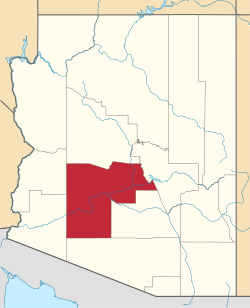Vulture Mine
Vulture Mine was a gold mine which was discovered in 1863. It was the most productive gold mine in the history of Arizona. From 1863 to 1942, the mine produced 340,000 ounces (9,638.8 kgs) of gold and 260,000 ounces (7,370.9 kgs) of silver. [1] [2] The mine was discovered when Henry Wickenburg, a prospector from California's gold rush, stumbled upon a quartz deposit containing gold while traveling in Arizona. Wickenburg began mining the outcrop himself.
In 1863, after Henry Wickenburg discovered the mine, Vulture City, a small mining town, was established in the area. Vulture City's post office was established on October 4, 1880, and Henry Wickenburg was the town's first postmaster. The town had more than five boarding houses and several buildings. The huge Vulture Mine-Assay Office building, built in 1884, still stands today. The town also had a cookhouse and mess hall plus stores, saloons and even a school. [3] The town once had a population of 5,000 citizens. It was marked by violence. Eighteen men were hanged on an ironwood tree located by the ruins of Henry Wickenburg's house. [4]
Abandonment
After the mine closed, the city was abandoned and its buildings decayed, becoming a ghost town. The deposit was later sold to Benjamin Phelps, who represented a group of investors that eventually organized under the name of Vulture Mining Company. The mine continued to produce at a decreased level until World War II, when it was permanently closed. More recently, the owner has offered a two-hour, dirt path guided walking tour of the mine. [1] [2] [3] [4]
This page is based on this
Wikipedia article Text is available under the
CC BY-SA 4.0 license; additional terms may apply.
Images, videos and audio are available under their respective licenses.

























